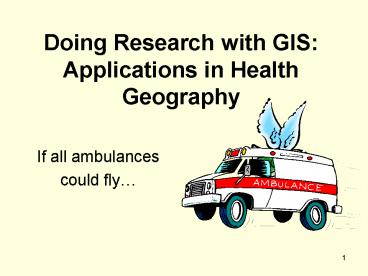Doing Research with GIS: Applications in Health Geography - PowerPoint PPT Presentation
1 / 22
Title:
Doing Research with GIS: Applications in Health Geography
Description:
Aaron Koning. 3. Research Question ... 'As the crow flies' reproduce results published by the Ministry of Health Services (1996 data) ... – PowerPoint PPT presentation
Number of Views:85
Avg rating:3.0/5.0
Title: Doing Research with GIS: Applications in Health Geography
1
Doing Research with GIS Applications in Health
Geography
- If all ambulances
- could fly
2
Undergraduate Level Research
- Geography Program, UNBC
- Jessica McGregor
- Neil Hanlon
- Scott Emmons
- Seamus Carroll
- Aaron Koning
3
Research Question
- Does access to emergency care meet provincial
standards in Northern British Columbia when
network analysis is used? - Comparing two methods of measuring geographical
accessibility in northern BC
4
Literature Review
- Correlation of Travel Time on Roads vs. Straight
Line Distance - Ciaran S. Phibbs and Harold Luft (1995)
- Normative Models and Healthcare Planning
Network-Based Simulations Within a Geographic
Information System Environment - Stephen Walsh, Phillip Page and Wilbert Gesler
(1997) - Examining distance effects on hospitalizations
using GIS a study of three health regions in
British Columbia, Canada - Ge Lin, Diane Allan and Margaret Penning (2002)
5
Study Area
6
Study Context
- Standards of Accessibility
- Emergency Care
- 24/7/52 basis
- within one hour travel time, or the Golden Hour
- for 98 of the population
- Method of Measurement
- Straight-line distance, or as the crow flies
7
Percentage of NHA Population within 50km of Acute
Care Facility by HSDA
Northwest 99.4
Northern Interior 98.1
Northeast 94.5
NHA Total 97.7
- Includes Diagnostic Treatment Centres, Federal
Nursing Stations and Red Cross Outposts - Source Standards of Accessibility and Guidelines
for Provision of Sustainable Acute Care Services,
Appendix 4
8
Data
- Hospital
- Road Data
- Enumeration Area Data (1996)
- Block Face Data (2001)
9
Methods
- As the crow flies reproduce results published
by the Ministry of Health Services (1996 data) - 2. Network Calculation (1996 data)
50km
10
Distance Analyzer Interface
11
(No Transcript)
12
Methods contd
- 3. Aerial and Network calculations (2001 data)
- Facility tables updated
- Population data at block face scale, 2001
13
Results
Aerial Analysis Population Within Golden Hour
1996 data 95
2001 data 91
Network Analysis Population Within Golden Hour
1996 data 92
2001 data 90
14
50 km buffers of 1996 facilities 95 within
golden hourBlack points indicate enumeration
area centroids
15
Network analysis of 1996 data 92 within the
golden hourBlack points indicate enumeration
area centroids
16
50km buffers of 2001 facilities 91.4 within
golden hourBlack points indicate block face
centroids
17
Network analysis of 2001 data 89.6 within
golden hourBlack points indicate block face
centroids
18
Comparing Network and Aerial Analysis
19
Discussion
- Challenges
- Georeferencing with postal codes
- Accuracy of route information
- Failure of Network/Enumeration Area Model
- Variability of block size
20
Discussion contd
- Policy Implications
- Informing policy makers
- Uncontrolled urban sprawl
- More money?
21
Conclusion
- The Benefits of Network Analysis
- Real distance and travel time
- Can adjust for seasonality and geography
- Important in rural areas where geographic
barriers reduce distance-travel time correlations
22
If all ambulances could fly putting provincial
standards of emergency care access to the test in
Northern British Columbia
- http//www.cma.ca/index.cfm/ci_id/44834/la_id/1.ht
m.

